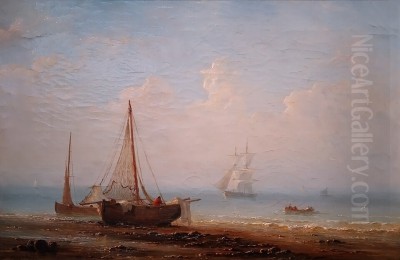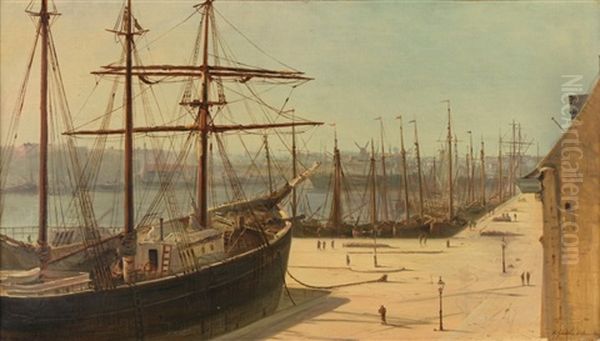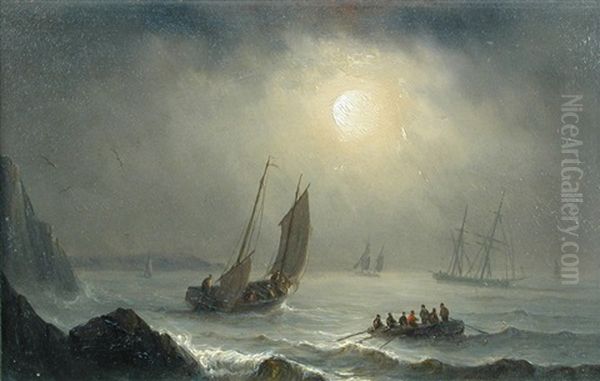
Henriette Hermine Gudin stands as a notable, albeit sometimes overlooked, figure in the rich tapestry of 19th-century French art. Born in Paris in 1825 and passing away in 1892, she carved a distinct niche for herself in the demanding genre of marine painting, a field overwhelmingly dominated by male artists during her time. As the daughter of the celebrated official marine painter Jean Antoine Théodore Gudin, she inherited a legacy steeped in maritime tradition, yet she skillfully navigated her own course, developing a unique artistic voice recognized by critics and exhibited at the prestigious Paris Salon. Her life and work offer a fascinating glimpse into the world of French Romantic marine art and the experiences of a female artist striving for recognition in a patriarchal era.
A Painter's Lineage: Early Life and Training
Henriette Gudin's artistic journey began under the direct influence of her father, Théodore Gudin (1802-1880). He was not merely a painter but a figure of national importance, holding the title of Peintre officiel de la Marine (Official Painter of the Navy) and renowned for his dramatic depictions of naval battles, shipwrecks, and expansive seascapes, often executed on a grand scale. Growing up in such an environment undoubtedly provided Henriette with unparalleled access to artistic training and a deep immersion in the subject matter that would define her career.
She became her father's student, learning the foundational techniques of oil painting and the specific challenges of capturing the nuances of water, sky, and vessels. While the exact details of her apprenticeship are not fully documented, it is clear that she absorbed the technical proficiency and thematic focus of the Gudin household. However, rather than simply replicating her father's dramatic flair, Henriette began to cultivate her own distinct sensibility, leaning towards more intimate and tranquil aspects of maritime life.
Debut and Recognition: The Paris Salon

The Paris Salon was the epicenter of the French art world in the 19th century, the primary venue for artists to display their work, gain critical attention, and secure patronage. For a female artist, acceptance into the Salon was a significant achievement. Henriette Gudin successfully navigated this competitive arena, exhibiting her paintings under the name "Gudin La Fille" (Gudin the Daughter) – a moniker acknowledging her lineage while asserting her individual presence.
Her works were featured in the Salons of 1848, 1849, 1850, and 1853. This consistent presence indicates a level of quality and acceptance that was not easily won. Contemporary critics took notice, acknowledging her skill. Sources mention that she received recognition for her fine handling of light and atmospheric effects, key elements in successful marine painting. Her ability to capture the subtle interplay of light on water and the mood of the sea garnered positive attention, establishing her reputation as a competent and talented artist in her own right.
The Gudin Style: Tranquility and Precision
While inevitably influenced by her father, Théodore Gudin, and the broader Romantic movement prevalent in the first half of the 19th century, Henriette developed a style characterized by tranquility, balance, and meticulous detail. Unlike her father's often turbulent and historically charged canvases, Henriette frequently focused on calmer waters, serene harbor views, and peaceful coastal scenes. Her works often depict fishing boats at anchor, merchant vessels under gentle sail, or quiet moments along the shoreline, populated by fishermen going about their daily lives.
Her paintings are noted for their precise rendering of ships, rigging, and architectural elements within harbors. This attention to detail, likely honed under her father's tutelage, lent authenticity to her scenes. Furthermore, her use of color, often described as romantic, contributed to the overall mood of her work, emphasizing atmosphere and the subtle beauty of the maritime environment. She displayed a particular skill in capturing light effects – the glint of sun on calm water, the soft haze of morning, or the warm glow of sunset, all rendered with a delicate touch. Her canvases were generally smaller in scale compared to her father's major works, contributing to their intimate and accessible quality.
This focus on calmer, more picturesque scenes aligns with a specific vein of Romantic marine painting, one that appreciated the quiet beauty and inherent spirit of nature, contrasting with the sublime terror often explored by other artists of the era, such as in the dramatic shipwrecks painted by Claude Joseph Vernet in the previous century or the more turbulent seascapes sometimes favored by her own father.
Signature Seascapes: Notable Works

Several works exemplify Henriette Gudin's artistic output and style. One of her most frequently cited representative pieces is Merchant Ships on a Calm Sea (undated). This small painting, measuring only 14 x 21 cm, is housed in the International Maritime Museum in Hamburg. Its modest scale and tranquil subject matter are characteristic of much of her known work, showcasing her ability to create compelling maritime scenes within an intimate format.
Another documented painting is Le port d'Ostende (The Port of Ostend), dated 1878. Measuring 41 x 71 cm, this work demonstrates her continued engagement with harbor scenes later in her career. Its recorded auction estimate of €5,000 to €8,000 indicates the value her work commands in the art market. Additionally, works titled simply Seascape or attributed as "Manner of Henriette Gudin" appear in collections and auctions, reflecting her established style.
An intriguing reference links her to a work titled Mantalivet Médoc à la grande côte, noted as being painted by Louis Auguste Auguin (1824-1903), a landscape painter associated with the region near Bordeaux. The exact nature of this connection in the source material is slightly ambiguous, but it suggests potential interactions within artistic circles, perhaps indicating shared subjects, patronage, or regional connections, placing her within a network of contemporary landscape artists.
Life Beyond the Easel: Marriage and Identity
In 1850, Henriette Gudin married Étienne François Fauchier, and they reportedly had a son. This life event marks a significant personal transition, yet interestingly, it did not immediately alter her professional identity. For approximately fourteen years after her marriage, she continued to sign her paintings with her maiden name, "Henriette Gudin." This decision speaks volumes about her commitment to her artistic career and her established reputation.
Only around 1864 did she begin to sign her works as "Mme Fauchier." This eventual adoption of her married name was common practice at the time, but her prolonged use of "Henriette Gudin" suggests a conscious effort to maintain the artistic identity she had built through her Salon successes and critical recognition. It reflects the careful negotiation many women artists undertook to balance societal expectations with their professional aspirations.
Artistic Circles and Contemporaries
Henriette Gudin operated within the vibrant artistic milieu of mid-19th-century Paris and France. Her most significant connection was undoubtedly her father, Théodore Gudin, whose fame provided both opportunity and a standard against which she might be measured. Her documented collaboration with the British painter Sarah Louise Kilpack (dates uncertain, active mid-19th century), with whom she reportedly worked in Paris for three years, points to direct professional exchange and perhaps shared studio practice, offering a rare glimpse into her working relationships.
Her connection, however indirect, to Louis Auguste Auguin further situates her within the broader landscape of French regional painting. While primarily a marine painter, her work shares the 19th-century French focus on capturing specific locales and atmospheres, a trait found in the works of the Barbizon School painters like Théodore Rousseau (1812-1867) and Jean-Baptiste-Camille Corot (1796-1875), though their primary focus was inland landscape.
Her style can be contextualized alongside other marine specialists. Eugène Isabey (1803-1886) was another prominent marine and landscape painter known for his Romantic, often historically themed scenes. Later in the century, Eugène Boudin (1824-1898), a key precursor to Impressionism, became famous for his luminous beach and harbor scenes, focusing intensely on light and atmosphere, perhaps representing an evolution from the more tightly rendered style Gudin practiced. The Dutch painter Johan Barthold Jongkind (1819-1891), active in France, also significantly influenced the development of marine painting towards Impressionism.
Compared to the burgeoning Realism movement led by figures like Gustave Courbet (1819-1877), Gudin's work remained firmly rooted in the Romantic tradition. Her contemporaries also included artists focused on different subjects, such as the peasant scenes of Jean-François Millet (1814-1875) or the highly successful animal paintings of Rosa Bonheur (1822-1899), another prominent female artist who achieved international fame. Other landscape artists like Charles-François Daubigny (1817-1878), known for his river scenes, and Félix Ziem (1821-1911), famed for his views of Venice and Constantinople, were also part of this rich artistic landscape.
Navigating a Male Domain: Challenges and Achievements
To be a female painter in the 19th century was challenging; to specialize in marine painting, a genre often associated with seafaring, naval history, and direct observation from boats, was rarer still. Henriette Gudin's success in exhibiting regularly at the Salon and gaining critical notice was a significant accomplishment. She demonstrated that women could master the technical demands of marine art and contribute meaningfully to the genre.
However, her position was not without potential complexities. Some sources mention a degree of controversy or commentary suggesting her success might have been partly attributed to her father's influence and connections, rather than solely her own merit. While impossible to definitively prove or disprove such claims retrospectively, they reflect a common hurdle faced by women artists of the era, whose achievements were sometimes viewed through the lens of their male relatives or mentors. It highlights the societal biases that could complicate the reception of female talent.
Despite any such commentary, the tangible evidence points to genuine achievement: acceptance into multiple Salons, positive critical mentions for her technical skill, and the creation of a body of work with a distinct style. Her career, like that of Rosa Bonheur, demonstrated that women could attain professional standing and recognition in the competitive Parisian art world, even in traditionally male-dominated genres.
Enduring Currents: Legacy and Influence
Henriette Gudin's legacy lies in her contribution to French marine painting and her position as a pioneering female artist within that specific field. She successfully navigated the expectations and challenges of her time to build a recognized career. While her father may be remembered for grander, more dramatic canvases, Henriette carved out her own space with works characterized by intimacy, tranquility, and careful observation.
Her paintings offer valuable examples of mid-19th-century Romantic marine art, capturing the quieter side of coastal life with sensitivity and skill. The presence of her work in museum collections, such as the International Maritime Museum in Hamburg, ensures its continued visibility. Although existing records do not indicate involvement in specific artistic movements beyond the mainstream Salon system, nor participation in women's rights activism or public discourse on the status of female artists, her professional success itself served as an implicit statement.
She remains a testament to the female artists who pursued their craft with dedication during a period when their participation in the professional art world was still far from equitable. Her focus on serene, meticulously rendered maritime scenes provides a counterpoint to the more turbulent or heroic narratives often found in the genre, enriching our understanding of 19th-century marine painting.
Conclusion
Henriette Hermine Gudin was more than just "Gudin's daughter." She was a skilled and dedicated artist who made her own mark on the world of French marine painting. Emerging from the shadow of her famous father, she developed a distinct style focused on the tranquil beauty of harbors and coastlines, rendered with precision and atmospheric sensitivity. Her regular participation in the Paris Salon and the recognition she received underscore her talent and perseverance. As one of the few women specializing in marine art during the 19th century, her career is significant not only for the quality of her work but also for her achievement in gaining visibility and respect in a male-dominated field. Her paintings endure as charming examples of Romantic marine art and as evidence of a female artist successfully navigating the currents of her time.